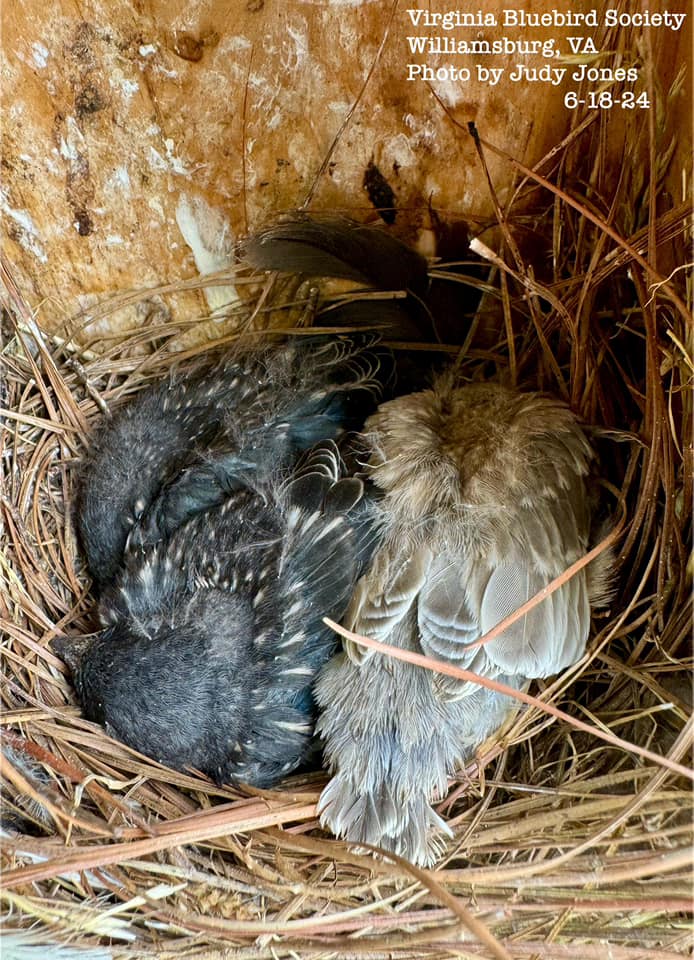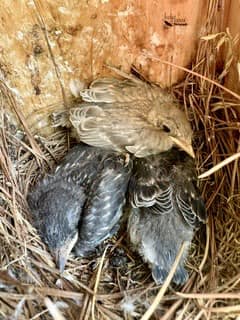Not all bluebird eggs are blue, not all blue birds are bluebirds, and not all bluebirds are blue!
Bluebird trail monitor Judy Jones came across something quite unusual while checking a nestbox in Chickahominy Riverfront Park in Virginia – a brown bluebird! The nestling was a creamy brown/beige color. A close up photo she took shows faint blue coloring near the tail. Its two nestmates had typical coloring, as did both adults rearing them.
When some folks on Facebook saw a photograph, they assumed it was a cowbird. However:
- the monitor had not seen a cowbird egg in the nest
- the brown nestling was the same size and form as its nestmates
- cowbirds usually hatch earlier than the host birds’ eggs (and thus are usually larger than nest mates) and are darker in color.

Photo by Judy Jones, brown bluebird nestling in VA

Christine Boran of the Virginia Bluebird Society consulted with Nestwatch’s Holly Grant and Dr. Kevin McGowan of Cornell. They responded that the weird coloration is most likely due to some kind of genetic anomaly related to pigments, but it’s hard to tell exactly what went awry without testing DNA.
Dr. McGowan indicated the coloring is probably not:
- from the feathers being bleached by the sun (since it is inside a nestbox!)
- because of advanced age (it’s a baby!)
- due to a nutritional deficiency (nestmates feathers are a normal color)
- not related to feather structure (blue feathers look blue because of the way light refracts off the feather), (then it would probably only affect feathers that would normally be blue.)
I found an interesting report online of a female adult brown bluebird seen in July 2022 in Jonesboro, Arkansas (Schroeder, 2014.) The authors indicated that:
- The female that was the subject of the paper was a “brown phenotype,” or brown mutation, as opposed to a leucistic bird or a bird with a “dilute gene” (e.g., as found in pigeons.) [Note: I’m not an avian geneticist and don’t really understand the difference. Some people use the term leucism in reference to any genetic misfire resulting in loss of pigmentation.]
- If the link is still live, you can see photos of the Arkansas brown bird here.
- The chestnut-colored breast on bluebirds comes from a combination of eumelanin and phaeomelanin pigments (Siefferman & Hill, 2003). Unusual brown feather coloring can come from a mutated TYRP1 gene, which results in “incomplete synthesis of eumelanin.” (Domyan et al., 2014; Kobayashi et al., 1998).
- Because TYRP1 is on the Z chromosome in birds, females (ZW) are more likely than males (ZZ) to express the brown trait.
- Despite its unusual coloration, the brown female that was the subject of this paper did find a mate, and raised four normally colored chicks.
- However, DNA analysis of the parents and the nestlings indicated that, while the brown female was related to the nestlings, she was most likely not their mother, but was instead a second degree relative! Who would have guessed that without banding or genetic testing!
Anyway, this is a great example of why monitoring is worthwhile. If no one had been checking this box, they never would have found such an oddity.
Note: information about this mutant was submitted to Cornell’s Nestwatch, where they report on all kinds of rare finds, like Dark-eyed Juncos (which are considered “open cup”nesters) using a nestbox.
MORE INFORMATION & RESOURCES:
- Genomic data reveal unexpected relatedness between a brown female Eastern Bluebird and her brood. Joseph L. Schroeder, Alexander J. Worm, Andrew D. Sweet, Virginie Rolland, First published: 24 January 2024 https://doi.org/10.1002/ece3.10851
- Cowbirds – Bio | Photos
- Leucism and Albinism in Bluebirds
- Misinformation Online
- White bluebird eggs
- Why and how to monitor
- Gynandromorphs (includes discussion of ZW and ZZ genes in birds)
- Feather Facts
- Why are bluebirds blue?
- Banding birds
- Dark-eyed Juncos using a closed nestbox https://nestwatch.org/connect/news/nestwatcher-finds-first-dark-eyed-junco-nesting-in-a-birdhouse/, and another using an open front nestbox: https://nestwatch.org/connect/blog/juncos-nest-in-a-birdhouse-part-two
Don’t believe everything you think.
